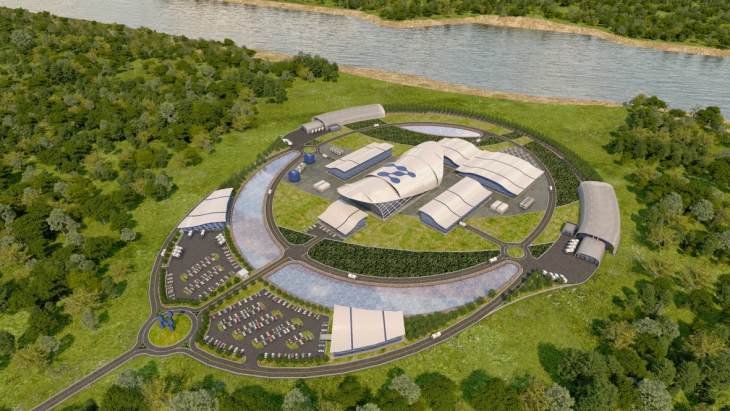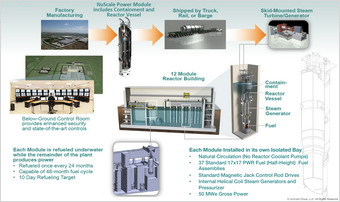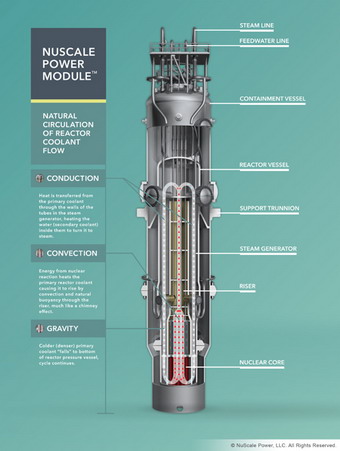
Ireland is a long way from deciding whether to use nuclear energy to help supply our electricity in a manner that is low in emissions while being affordable and reliable. But what would be the relevant details if Ireland decides to proceed with a nuclear plant?
Ireland’s first nuclear station will probably consist of a number of small units called Small Modular Reactors (SMRs).
The best location for this first station is probably Moneypoint, Co Clare, although the original site at Carnsore Point could also be suitable. A site of 15 acres is sufficient for a small nuclear station, which could make it suitable to replace many of the existing fossil fuel stations that are due to close by 2030. This would ensure a Just Transition for the local community.
A small nuclear station would produce electricity for between 5 and 8 cents per unit depending on a variety of factors, most of which are within our control.
A 300 MW station could cost as little as €1 billion, a large portion of which would be spent in Ireland on labour, materials and ancillary services.
Each such station would employ over 100 highly qualified, mostly Irish staff in well-paid jobs that would be secure for 60 years.
Many more Irish workers would be required during the 3-year construction period of each module.

Some of the potentially most suitable reactors (all SMRs) are listed below. Built underground (some are contained in large water tanks) for safety and security, they are passively safe even if all internal and external power is lost to the site (avoiding Fukushima-type incidents).
- NuScale is a US-designed SMR that can be configured in units of 4, 6 or 12 modules of 77 MWe each. A 4-module station would have an output of up to 308 MW, for example. This SMR is passively safe, has excellent load following capabilities, and is the first to receive US licensing certification. It is on schedule to be ready for deployment by 2027, with the first US-based customer aiming to commence operations in 2029. It aims to match the lifecycle costs of typical natural gas combined-cycle plants, targeting $2,850/kW for NOAK (nth of a kind) units.
- GE Hitachi is developing a 300 MW BWRX-300 SMR with passive safety systems; the simplest, yet most innovative Boiling Water Reactor (BWR) design since GE began developing nuclear reactors in 1955. Based on the ESBWR that has already been licensed, the BWRX-300 is designed for clean, flexible electricity. It aims to match the lifecycle costs of typical natural gas combined-cycle plants, targeting $2,250/kW for NOAK (nth of a kind) units.
- ‘Pebble Bed’ 210 MW plant, a gas-cooled design that can be used to produce hydrogen from water, the first of which is now being built in China and is being commissioned in 2021. These are inherently safe and cannot suffer a meltdown.
- Many people believe that Ireland’s first nuclear plant may be one of Molten Salt Reactors currently being designed or licensed. A particularly interesting design is the Stable Salt reactor from Moltex, as it promises to provide the cheapest and safest low carbon power available – and has an inbuilt energy storage capability.
- Terrestrial Energy Inc is a Canada-based molten salt reactor of up to 200 MW, with US and British cooperation, inherently safe salt fuel in 2 sealed and replaceable core vessels (sequentially removed every 7 years for off-site reprocessing when it has cooled and fission products have decayed). Emergency cooling and residual heat removal are passive. Projected to be competitive with natural gas. First commercial reactor anticipated by the late 2020s.
- An interesting option is the TerraPower 600 MW Travelling Wave concept, backed by Bill Gates of Microsoft fame, development of which has returned to the USA after some initial work was conducted in China.
- GE Hitachi 600 MW PRISM, inherently safe, can use spent fuel from other reactors as fuel. Produces much lower quantities of less radioactive waste than other designs. This Generation 4 plant would be a long-term option for Ireland, however.
More detail is given below on these issues, including up-to-date information and estimates where available. Final decisions in all these areas is for others to determine, of course – but we offer our view for the sake of discussion.
Location:

There is a number of suitable locations for nuclear power plants in Ireland as we are in an area of low seismic activity and have many areas of relatively low population density. Many coastal locations are suitable for thermal plants, and these would avoid the need for the large cooling towers that we show in this photo.
When nuclear energy was first proposed for Ireland in the 1970’s, the proposed location was at Carnsore Point in Co Wexford. That site would need to be assessed again to assess its potential, but it is still likely to be a suitable location as it has excellent geology. There is currently a small wind farm on the site, but this will be reaching its end of life around the time that we need to find a low carbon replacement for Moneypoint.
Another coastal site with good geology is Moneypoint itself, which has a history of power generation. Much of the infrastructure required of a large power station is already present at Moneypoint, including cooling water plant and connection to the national electricity grid – so it wouldn’t need extensive new cables and pylons that may be required in other locations.
Size:
The largest power generating unit in Ireland at present is over 400 MW. If unit size were to exceed around 500 MW, extra system costs would be incurred to maintain system security. 700 MW is generally considered to be the maximum capacity to avoid unreasonable extra system costs.
The Small Modular Reactors (SMRs) described above are all below 300 MW in size, except for the PRISM plant which consists of 2 blocks of 311 MW each supplying a common steam turbine of over 600 MW.
The 60 MW NuScale units are designed to be built in blocks of 6, total 470 MW, and 1 or 2 of these would be ideal for Carnsore Point. Moneypoint, on the other hand, is large enough to accommodate 3 blocks, resulting in a station of around 1400 MW, if that was appropriate.
There remains the issues of who would operate the plant, how would it be regulated and so on – please contact us if you would like to get our views on these matters.
